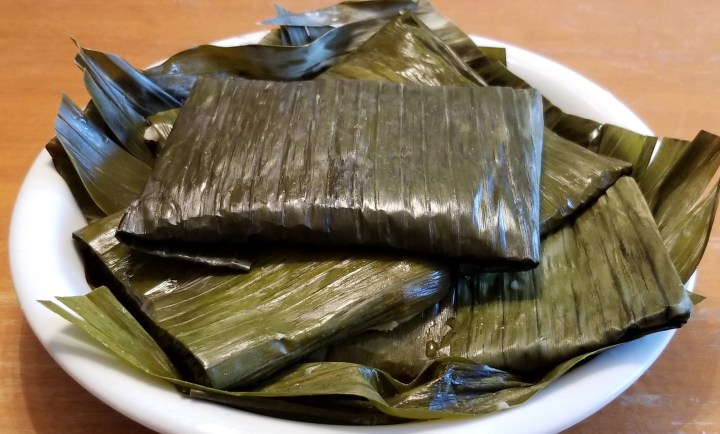
Click here to go to printable instructions: How to prepare frozen banana leaves.
Click here to go to printable recipe: Oaxaca Style Tamales.
Over the years, I have published several posts about the significance of the Mexican tradition of sharing a meal of tamales on February 2, which is marked on the Catholic calendar as Día de la Candelaria (Candlemas); please click here for my full story on the origin of Candlemas and corn offerings in Mexico. Nowadays, Día de la Candelaria celebrations in Mexico still involve church services for the blessing of candles and figurines representing baby Jesus for many people, but for the majority, it is mostly about the tamales. As detailed in a previous post, the meal is usually hosted by the person(s) who found figurines representing baby Jesus, hidden in the special bread that was served on Epiphany Day (January 6). Last year, I posted a summary of my recipes for tamales, atole, and hot chocolate for Candlemas; all the recipes shared on that summary called for corn husks as wraps for the tamales, so this year, I wanted to share a recipe using banana leaves.
In Mexico, in coastal and southern states, from Yucatan, Chiapas and Tabasco, to Veracruz, Oaxaca and Guerrero, there are many traditional recipes for tamales using banana leaves, although in Mexico City, many people call them all generically “tamales oaxaqueños” (tamales from Oaxaca). Conversely, there are many kinds of tamales in the state of Oaxaca alone, from the best known flat and square, to giant concoctions, such as tamal de bola (tamale ball), and others wrapped in edible herbs, not banana leaves; hence, using the term “tamales oaxaqueños” might become a quandary, in terms of accuracy and authenticity. I remember a lady near my parents’ place in Mexico City, selling her oaxaqueños, out of a bucket, just one kind, indeed wrapped in banana leaves, and filled with chicken and mole, and seasoned with an avocado leaf, so to honour my childhood memories, I am preparing those, with an option of green ones with tomatillo sauce, which are less known in Mexico city (where that flavour is usually wrapped in corn husks), but equally appreciated in Oaxaca. Vegetable oil may be used instead of lard, but it will definitely change the flavour, and especially the texture, of the dough. And just in case, I will call these tamales “estilo Oaxaca” – “Oaxaca Style”, so as not to offend the “authenticity police” who might be watching like a hawk (LOL), or more seriously, not to limit the scope of the many other types of tamales oaxaqueños that exist in that beautiful state.
Oaxaca Style Tamales – Tamales estilo Oaxaca
Printable recipe: Oaxaca Style Tamales.
Ingredients (for approximately 8 tamales)
Banana leaves, enough to get 8 pieces, each approximately a 10×10″ (25×25 cm) square
3 cups nixtamalized corn flour (masa harina, such as Maseca™; not corn starch)
3-4 cups hot water or broth (from cooking chicken, see below), as needed
1 cup + 3 tbsp lard, at room temperature; or vegetable oil
1 tsp salt
Fillings:
3 pieces chicken breast, preferably bone-in and skin-on
Water, as needed
¼ onion; peeled
1 cup cooked green sauce (click here for my homemade, or store-bought)
½ cup red mole or black mole paste (click on highlighted text for my recipes, or store-bought)
4 avocado leaves, if available (washed if fresh, or dried)
Prepare banana leaves: If starting with frozen leaves, place package in the fridge to thaw the night before, then allow to reach room temperature before preparing them for the tamales:
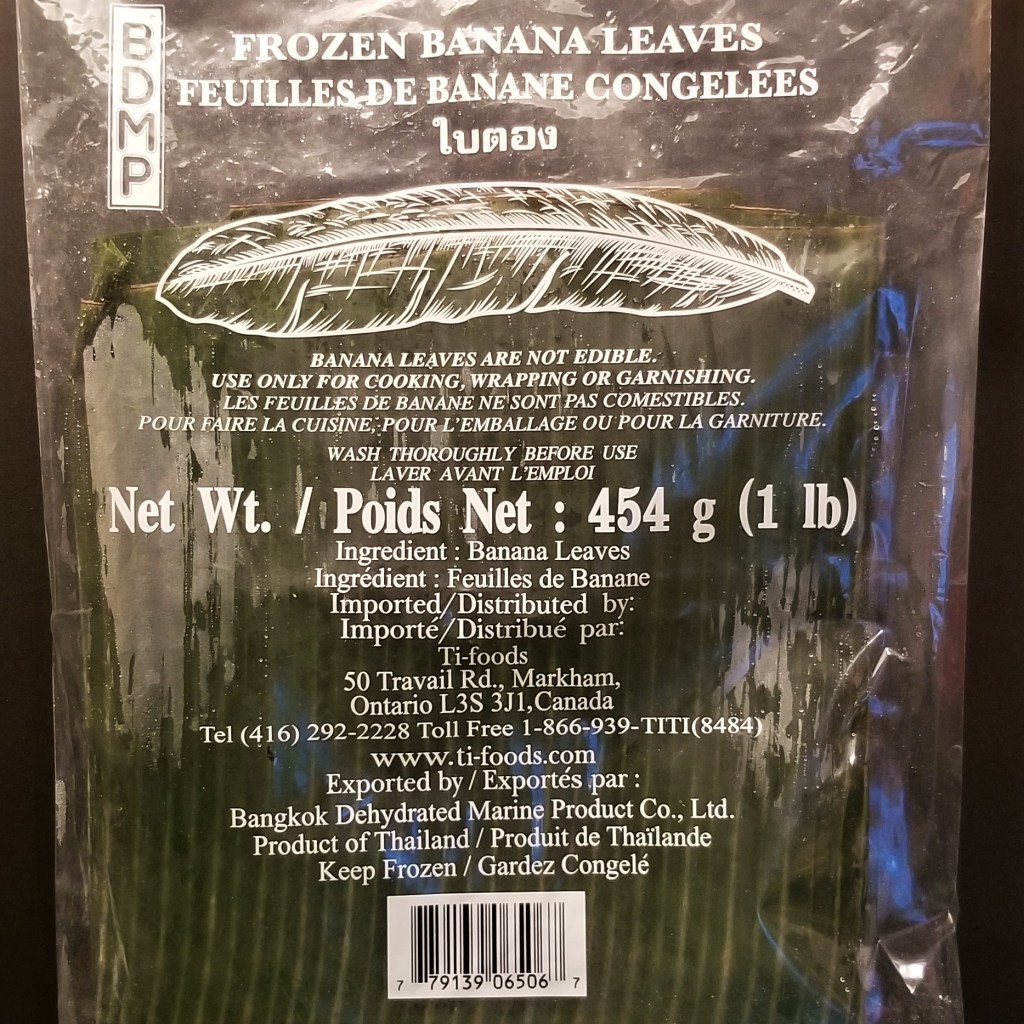
To clean them, place a tall pot or colander upside-down in the centre of the kitchen sink, then set up a cutting board on top; wash the banana leaves, one by one, by placing on the cutting board, washing with running water and gently rubbing with a clean cloth, while moving and folding the leaf to wash all the surface (photo below, left). Flip and repeat with the other side. Extend a kitchen towel on a counter, and place the clean banana leaf on top; dry with paper towels, flip and dry the other side (photo below, right):
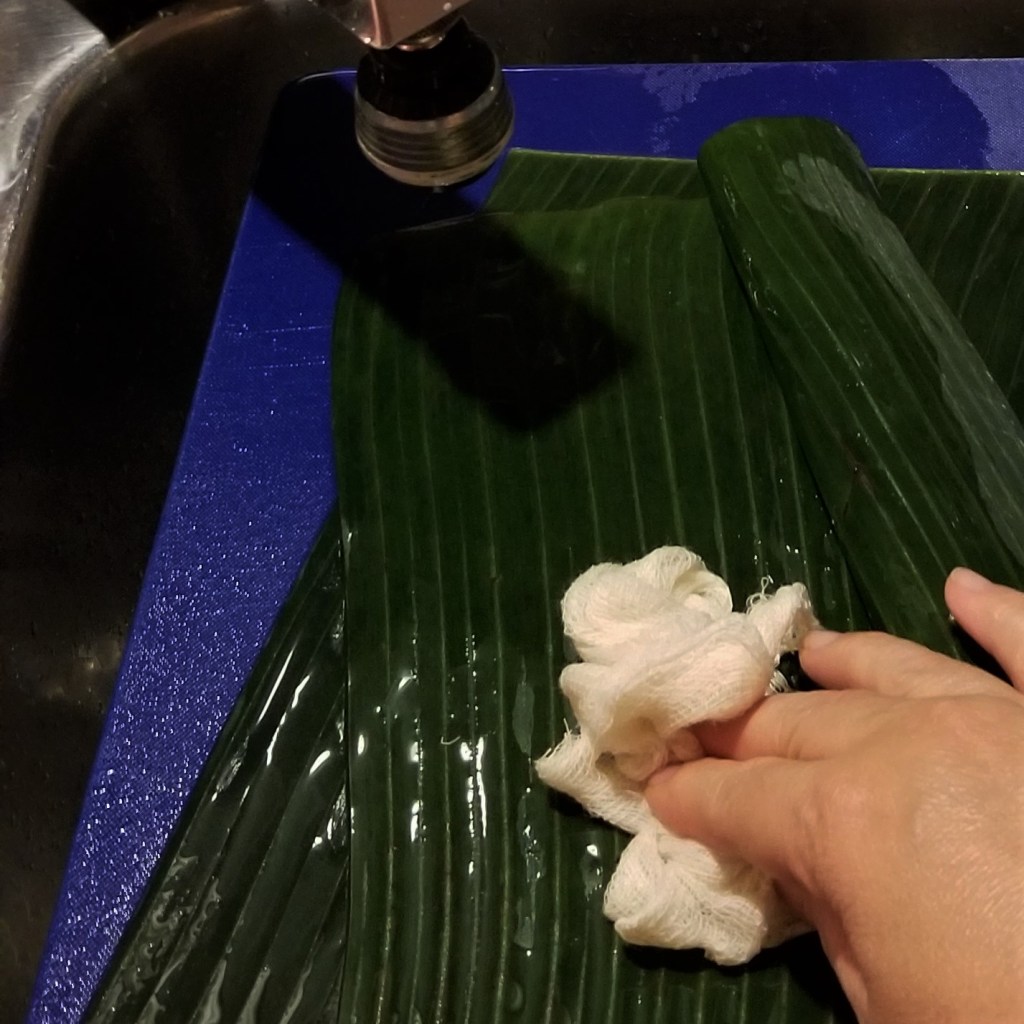
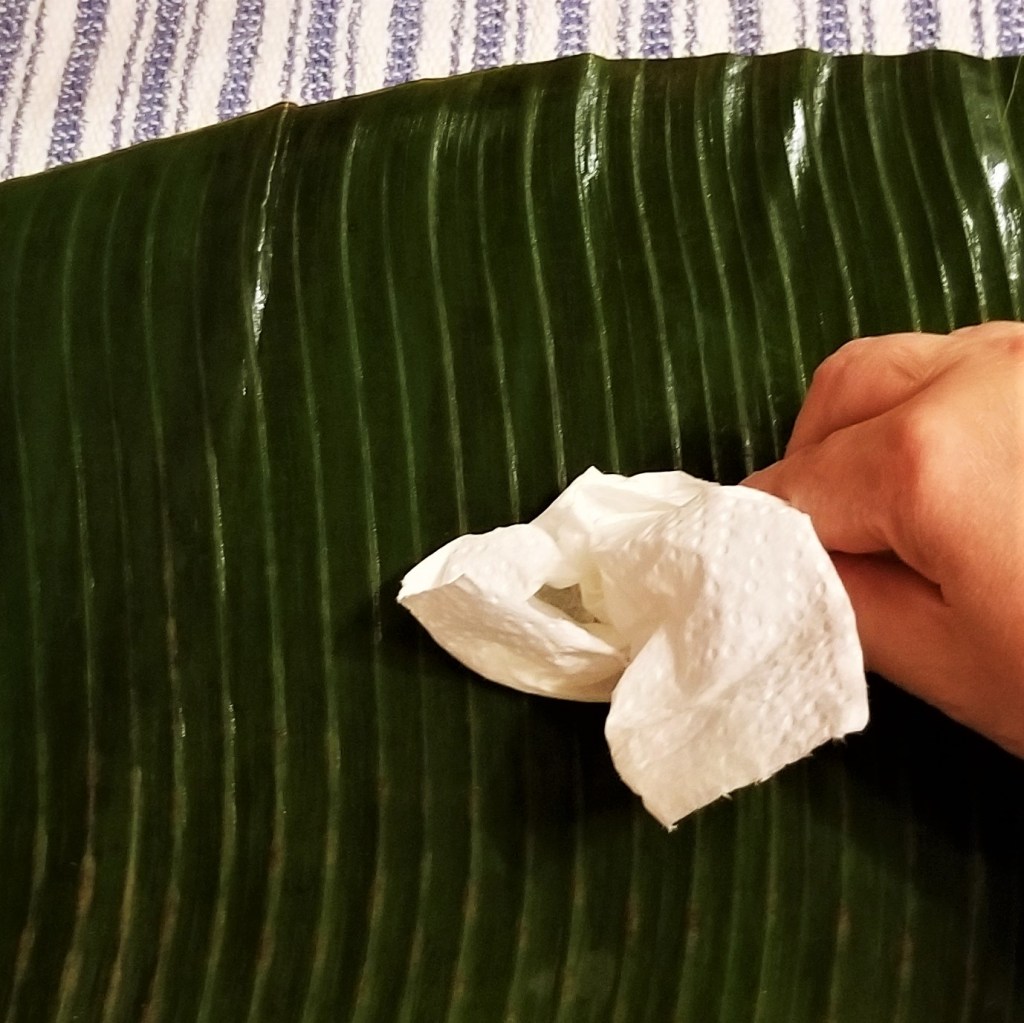
Repeat with the rest of the leaves.
The leaves are brittle at this point, so, to make them pliable, place a baking sheet on the stove over medium heat. Run the leaves over, one at a time, with the smooth side facing up; the surface will quickly become shinny:
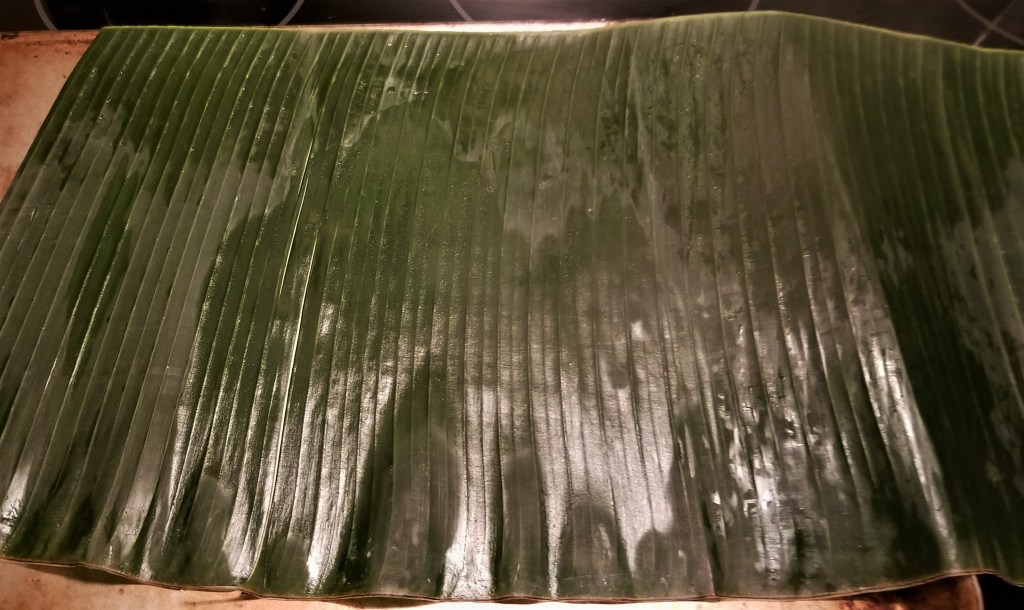
After a few seconds, the leaf will be pliable. Remove from heat and set aside. Do not over cook or they will burn and become brittle again. Cut banana leaves with scissors, to desired size, in this case, eight squares of approximately 10″ (25cm) per side. Set squares and leftover leaves aside.
Prepare fillings: Place chicken breasts and onion in a pot, cover with water and cook, covered, for 35 minutes. Allow to cool down, discard bones and skin, then shred the meat and reserve. Strain broth through a mesh and reserve. Add one half of the shredded meat to a pot with the green sauce; bring to boil, mixing and cooking for one minute (photo below, left). Remove from heat and reserve. In a bowl, mix the mole paste with enough hot water or broth just to get a thick sauce consistency, not runny. Mix this thick mole with the rest of the shredded chicken (photo below, right):
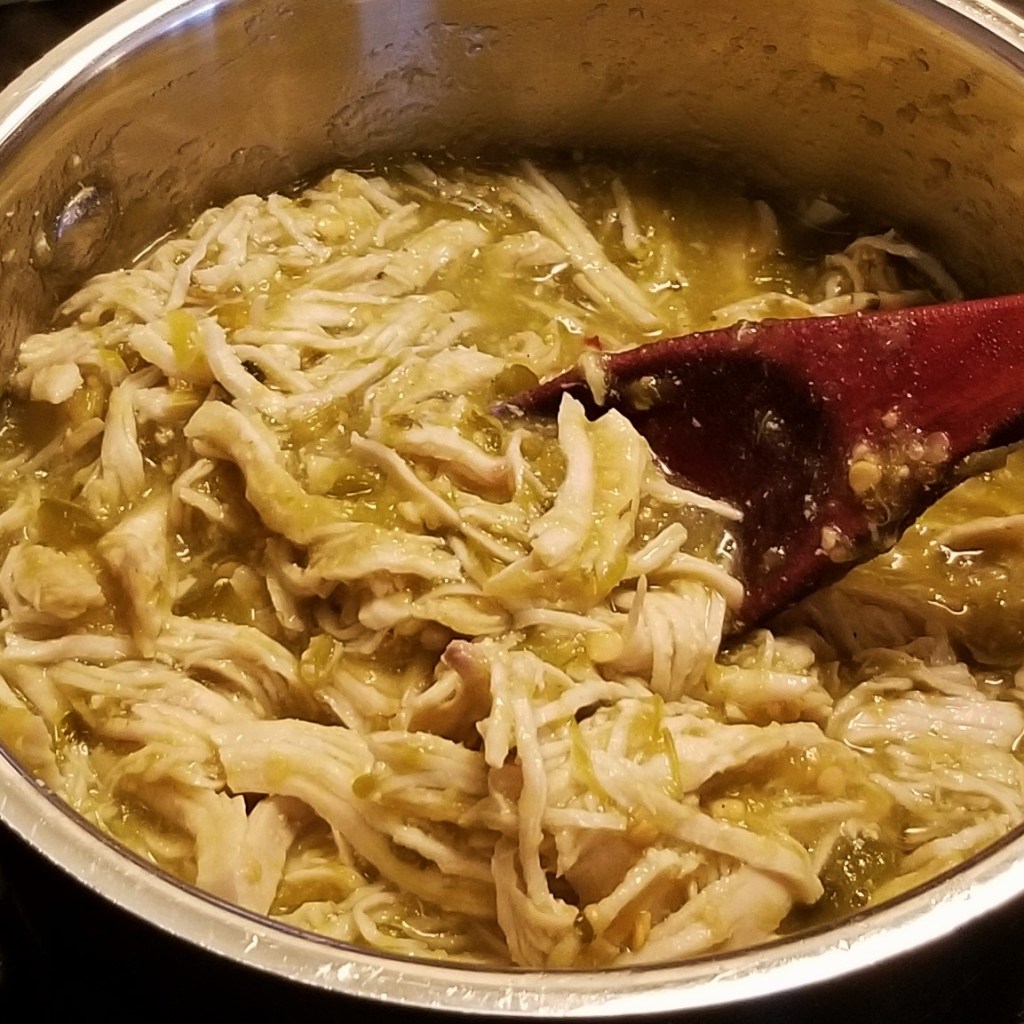
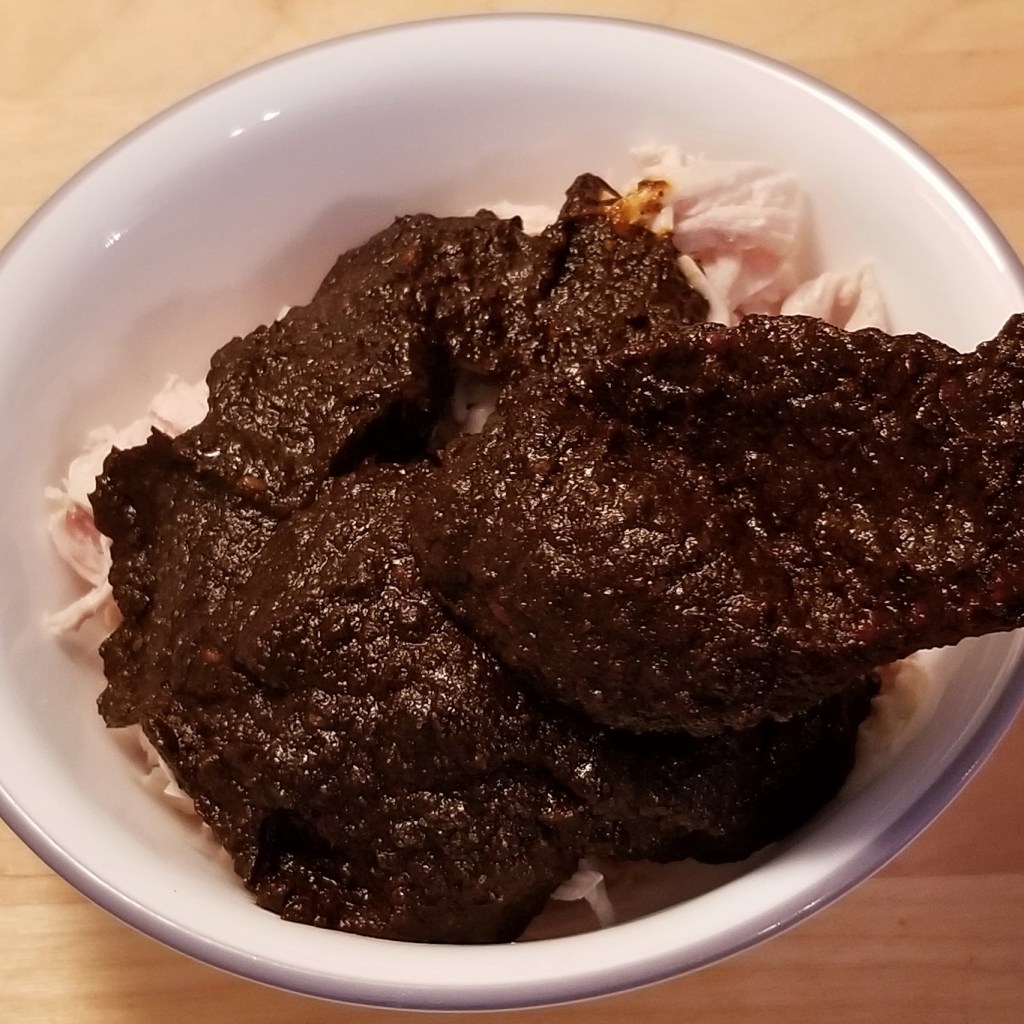
Set aside.
Prepare dough: Place corn flour, salt, and lard in a large mixing bowl, then pour in three cups of hot water (or reserved broth, photo below, left). Incorporate all ingredients with a spatula, or hands, adding more hot liquid, as needed, to obtain a soft – but not too runny – smooth paste (photo below, right):
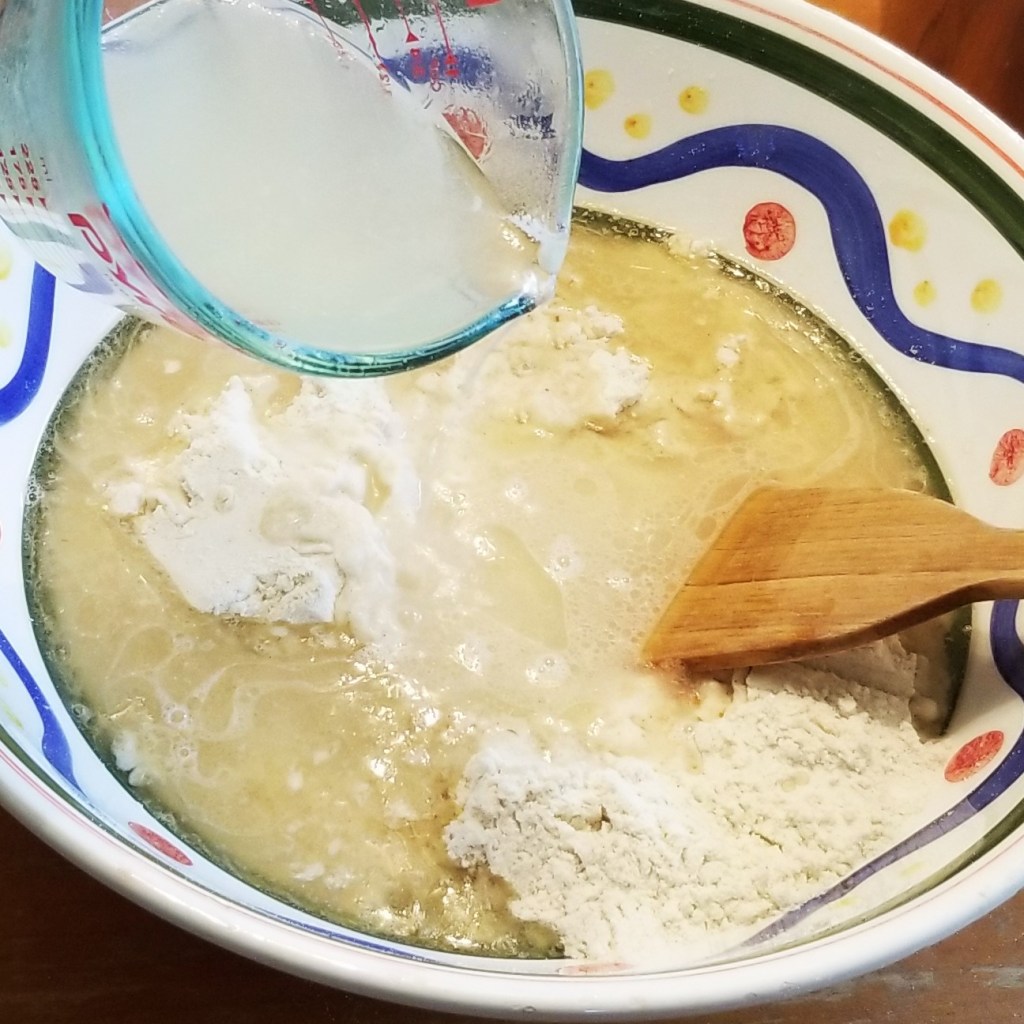
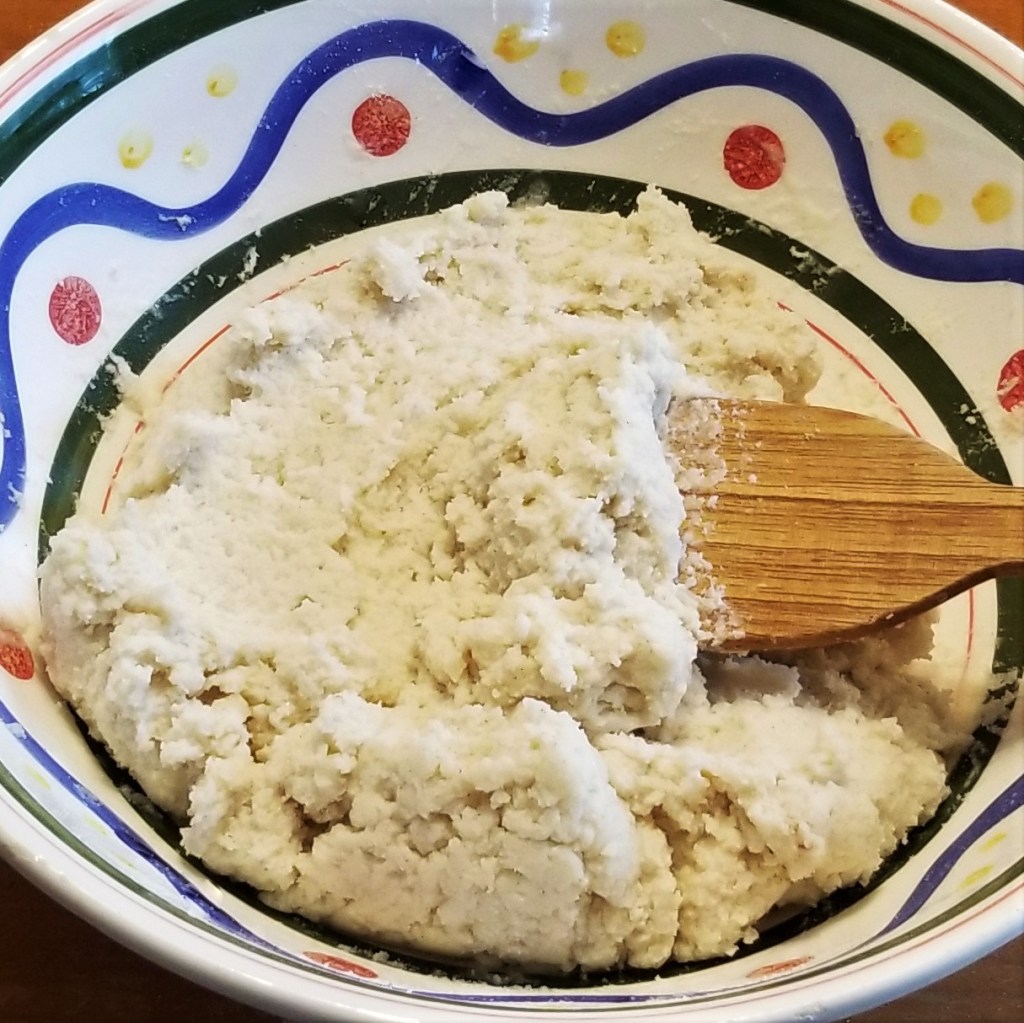
Assemble tamales: Place about three tablespoons of lard in a microwave safe container, and process until the lard melts (not necessary if using oil). Set on a working table, along with corn paste, fillings, avocado leaves and banana leaf squares. Set one square on the table, with the shinier side down:
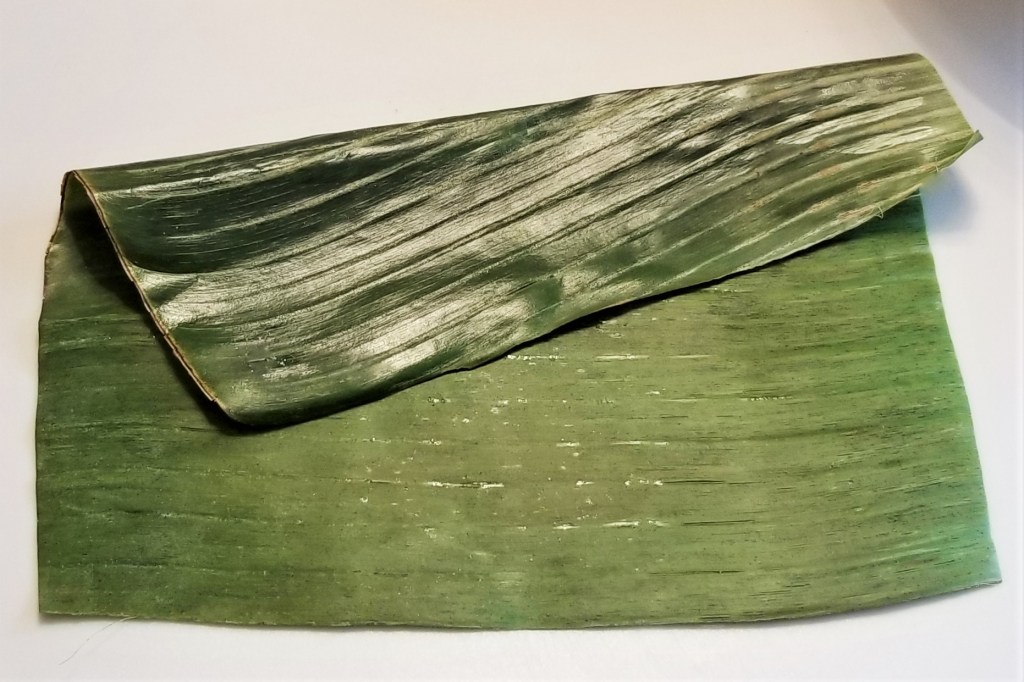
Spread about one teaspoon of melted lard (or oil) on the centre of the leaf, about a 5×5″ (12.5×12.5cm) area:
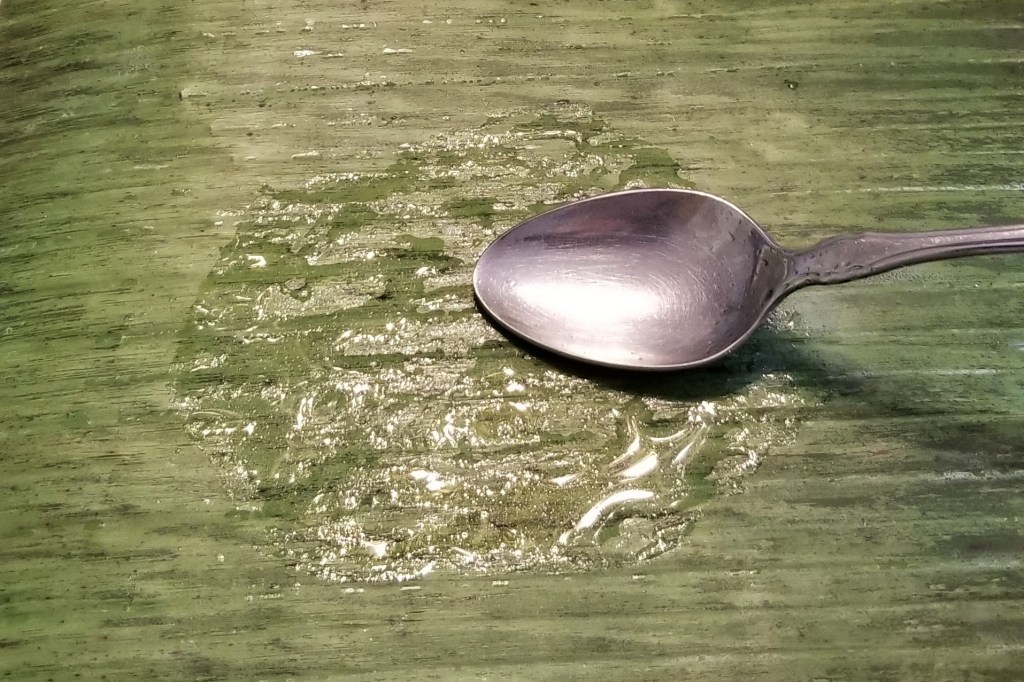
Take one eight of the corn paste and spread with hands on top of the lard:
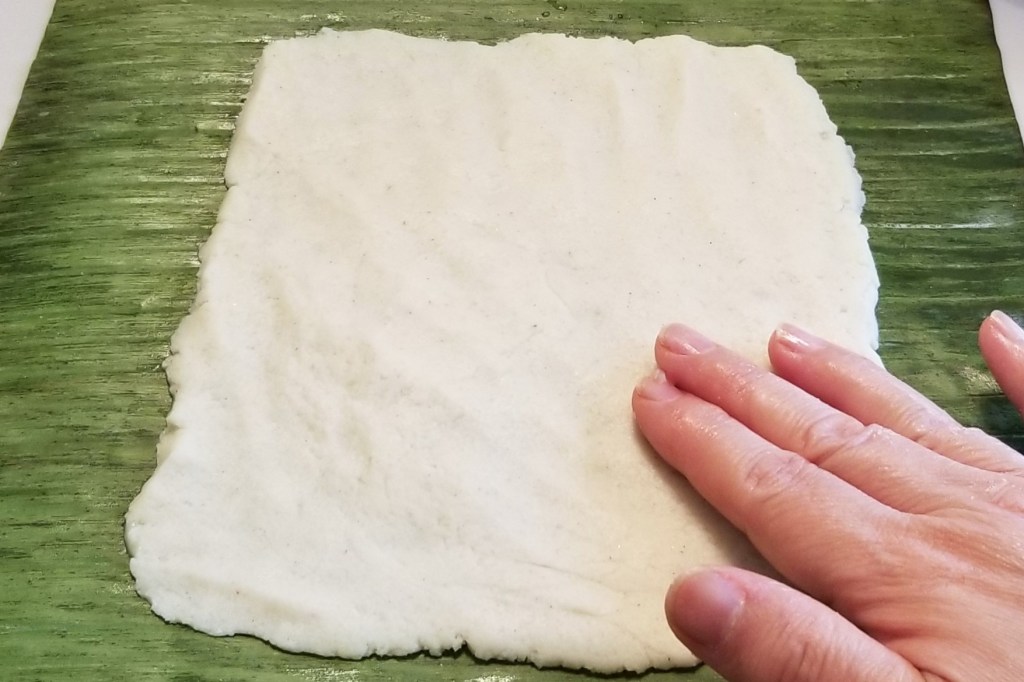
Scoop one quarter of one of the fillings onto the centre of the corn paste square, leaving one inch around the edges of the paste without filling. In the photos below, chicken with green sauce (left) and chicken with mole (right):
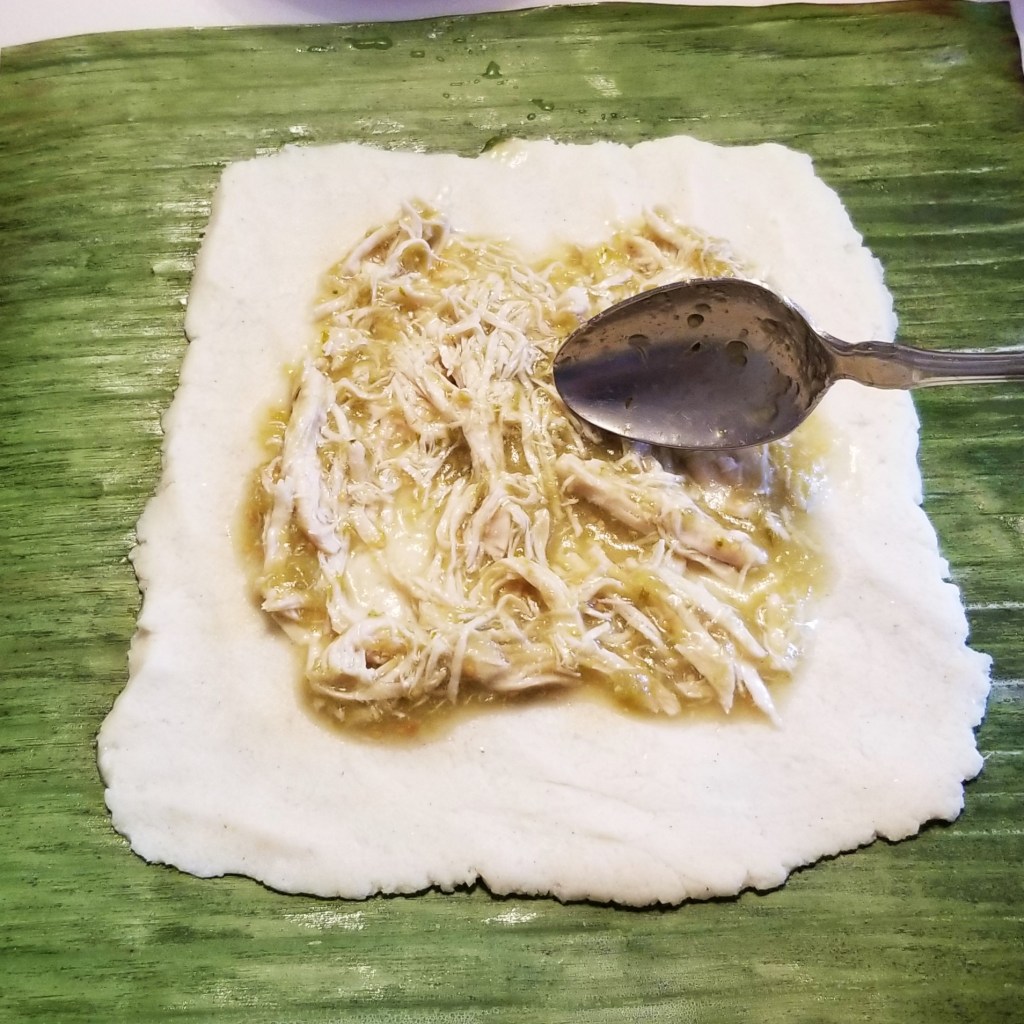
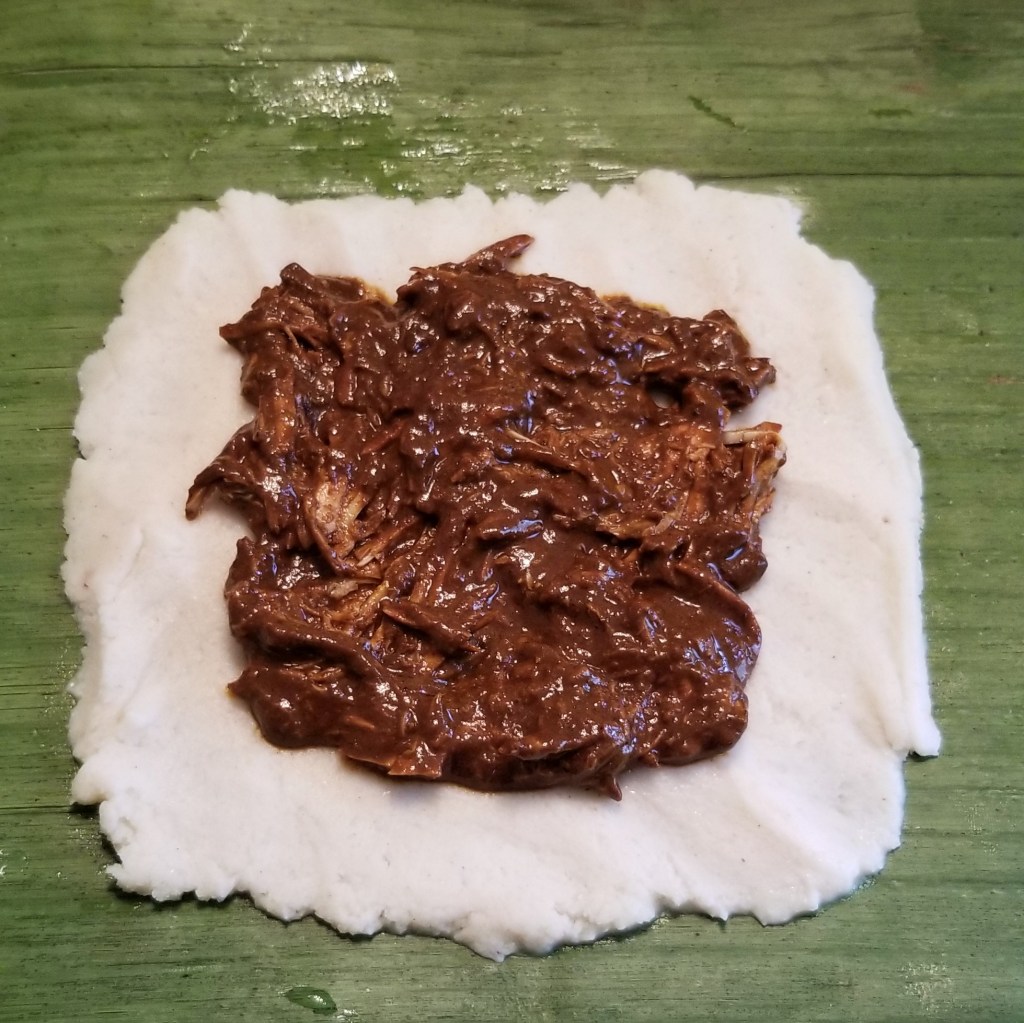
Fold and unfold the top third of the banana leaf, to separate corn paste, which will be partially covering the filling (photo below, left, with mole). For mole filling only, place one avocado leaf on top (photo below, right):
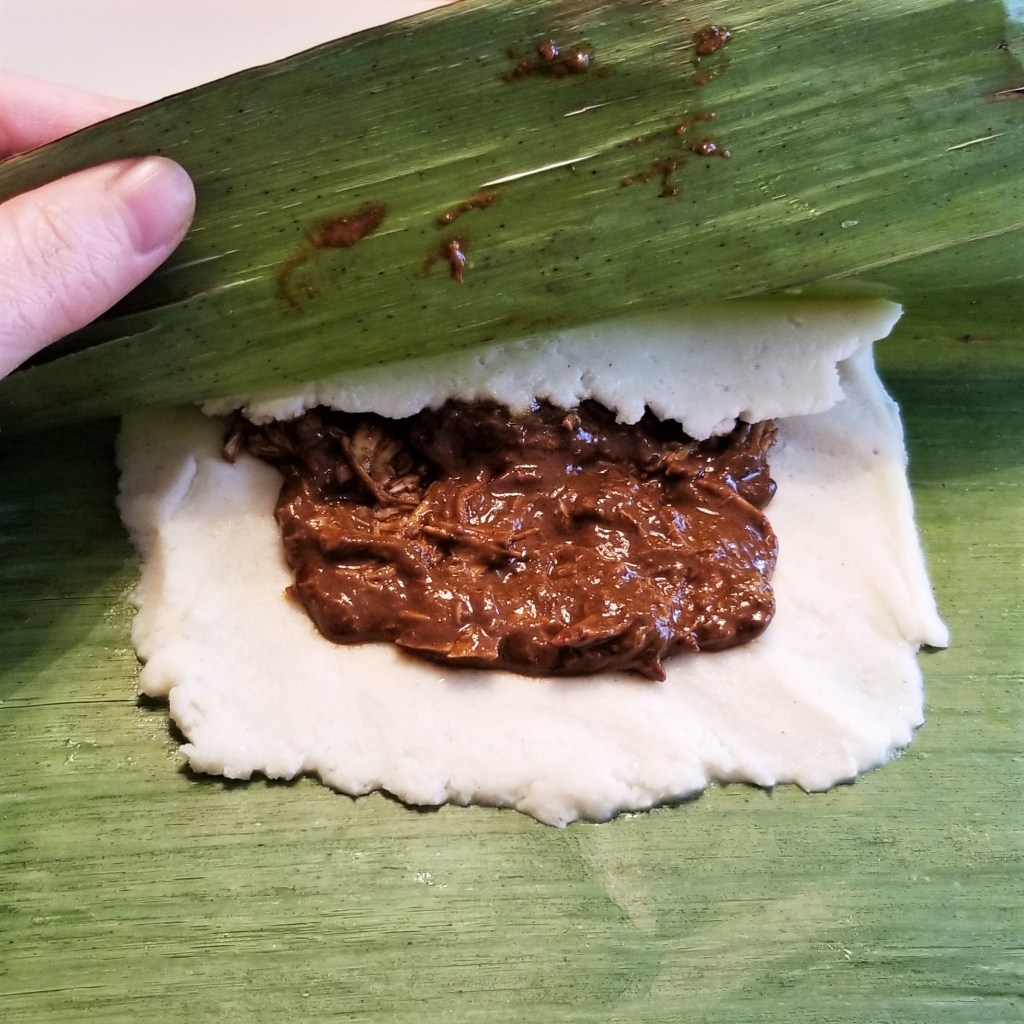
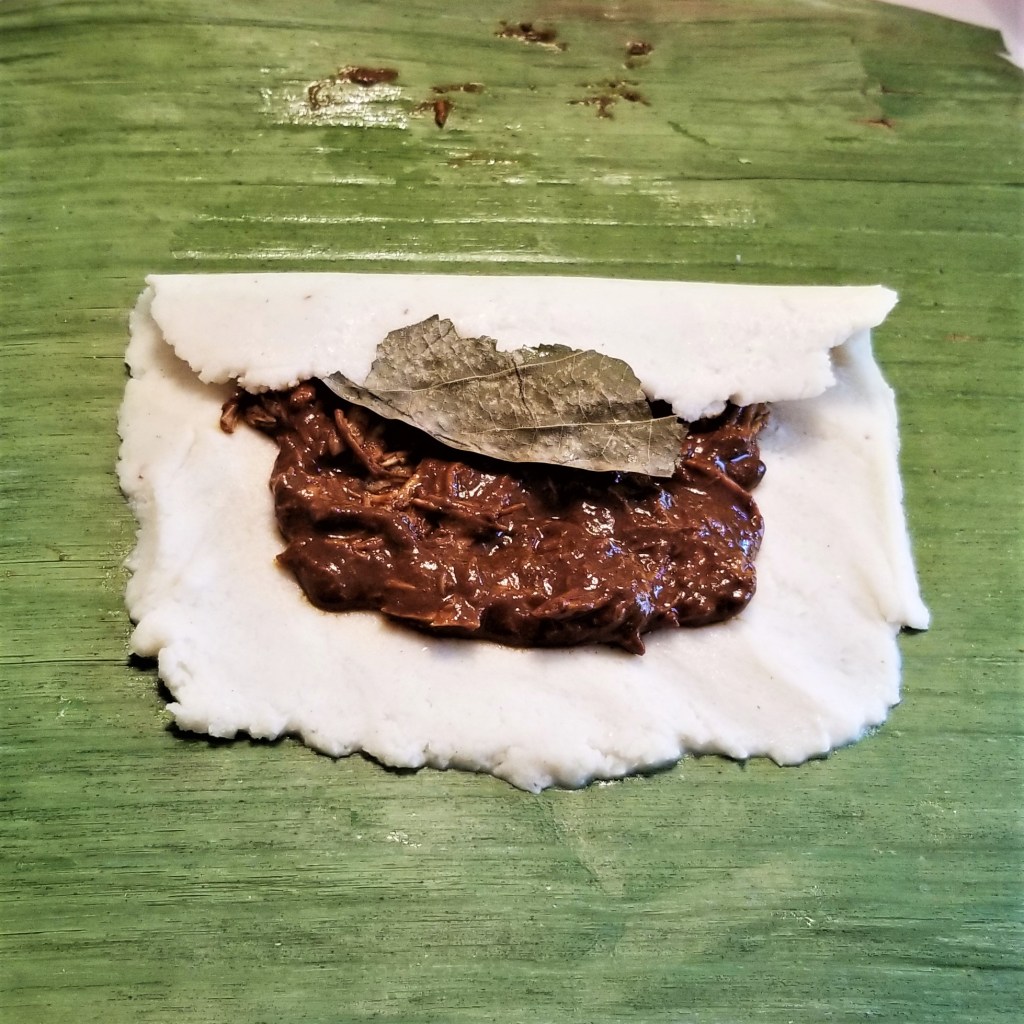
Now fold the bottom third of the banana leaf over the dough and filling (photo below, left). Fold the top third (now empty) over to form a band (photo below, right):
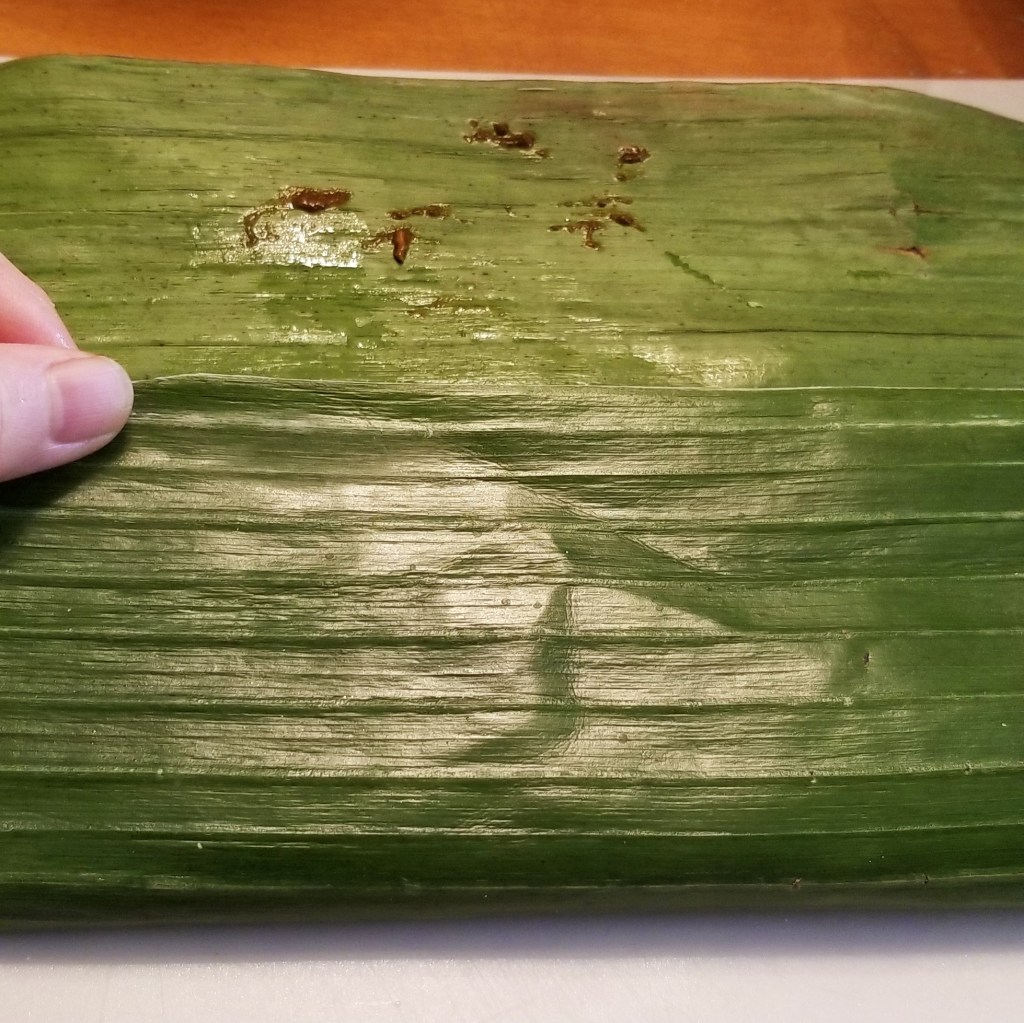
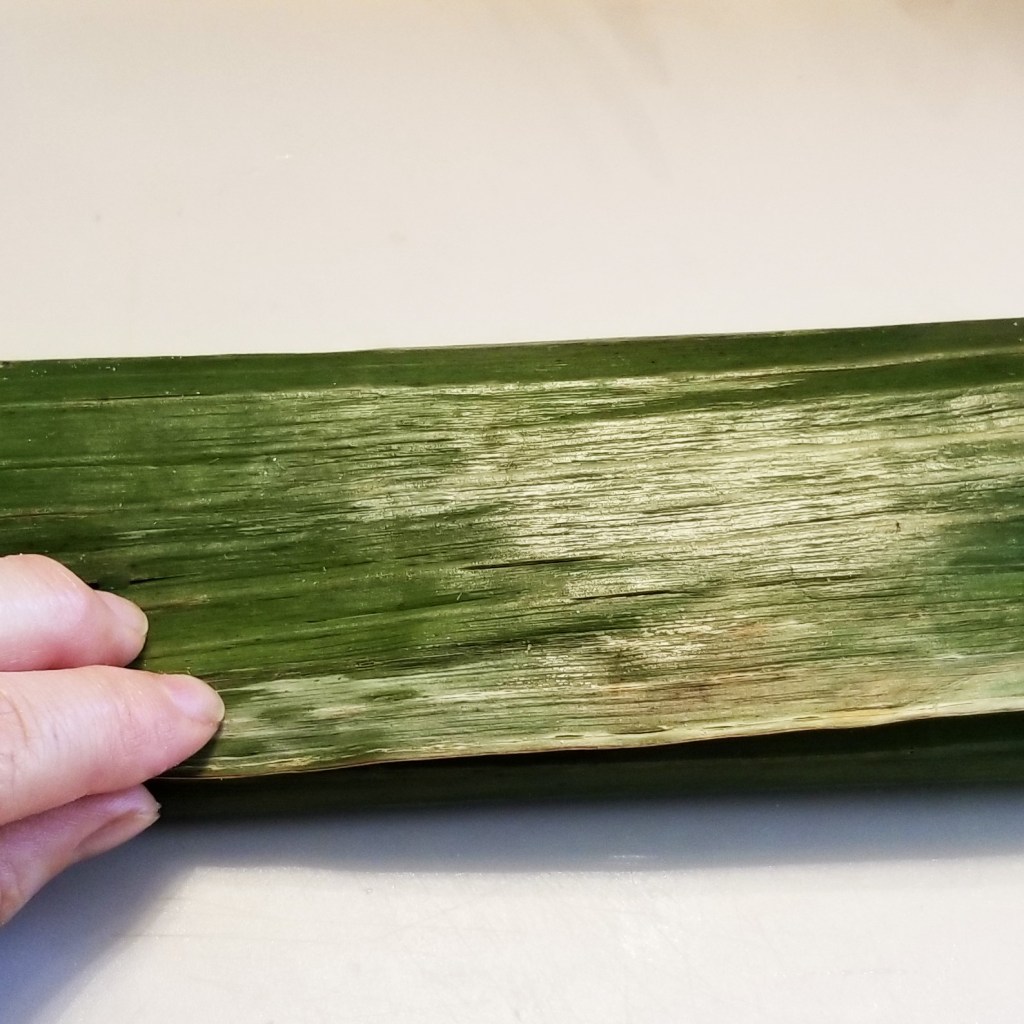
Finish closing the packet by folding the sides towards the centre (photo below, left). Flip to keep the sides from unfolding, to form an almost perfect square, or rectangular shape (photo below, right):
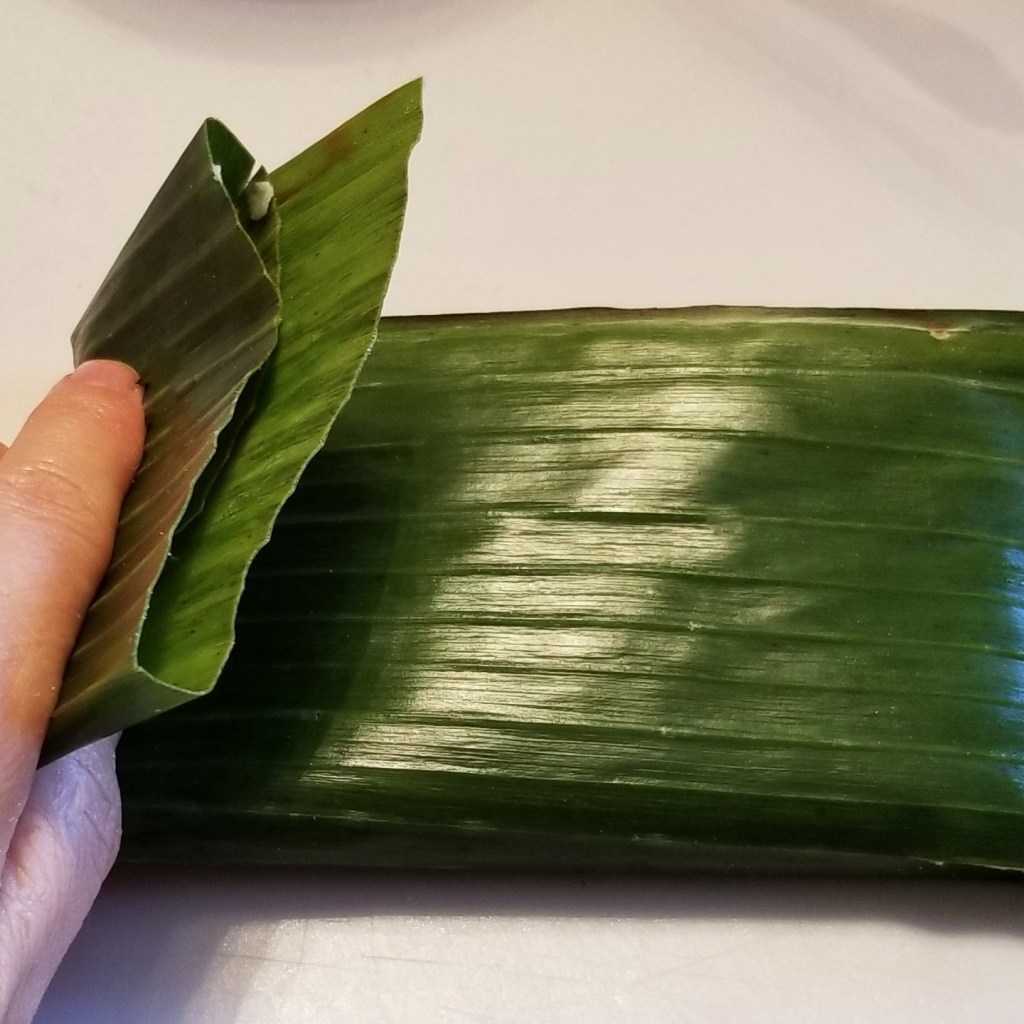
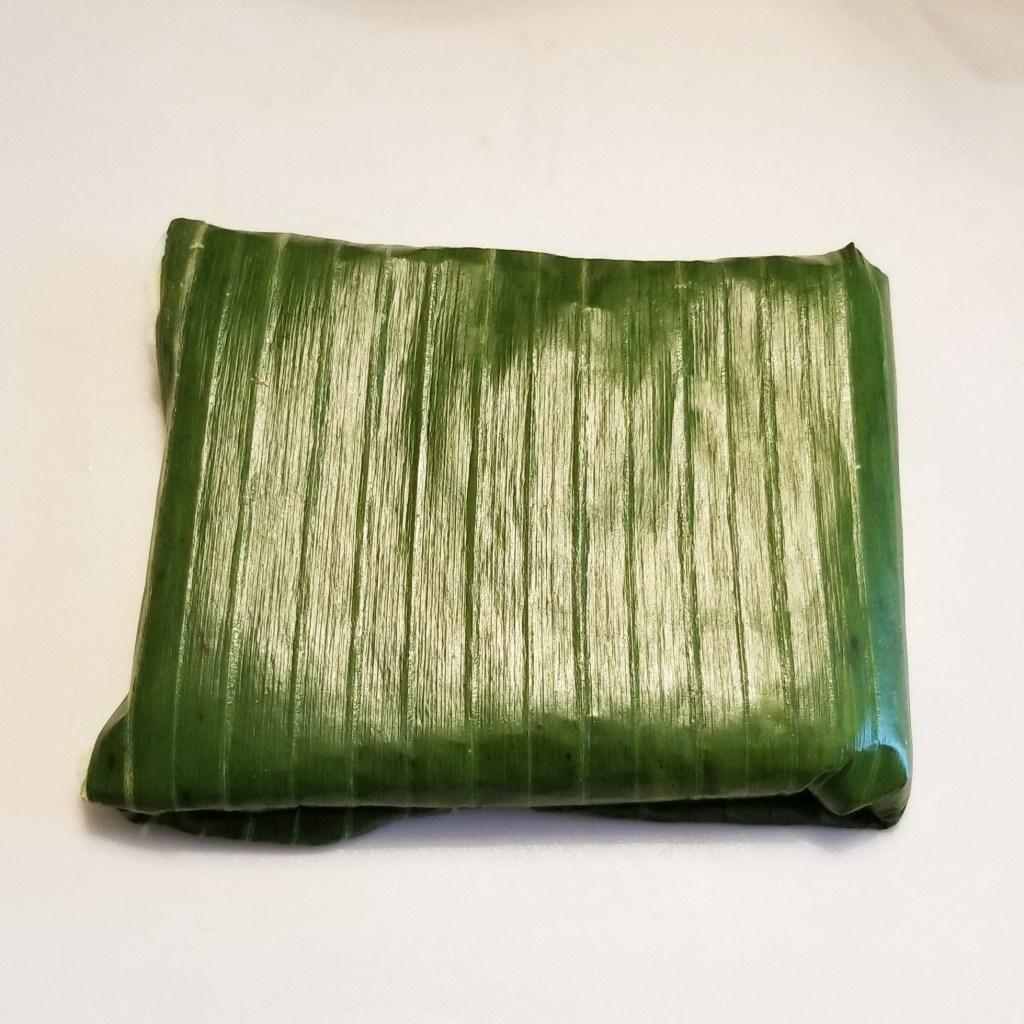
Repeat with the rest of the ingredients to form eight packets (omitting avocado leaf for green sauce tamales.)
Cook tamales: Prepare a large steamer by heating up water in the bottom pot, and lining the steaming basket with a layer of leftover banana leaves; I do not own a large steamer, so I always use a large metal colander that fits on top of my largest pot. Arrange the tamales in the prepared basket (or colander), in layers, forming a pile (photo below, left). Cover with more leftover banana leaves (photo below, right):
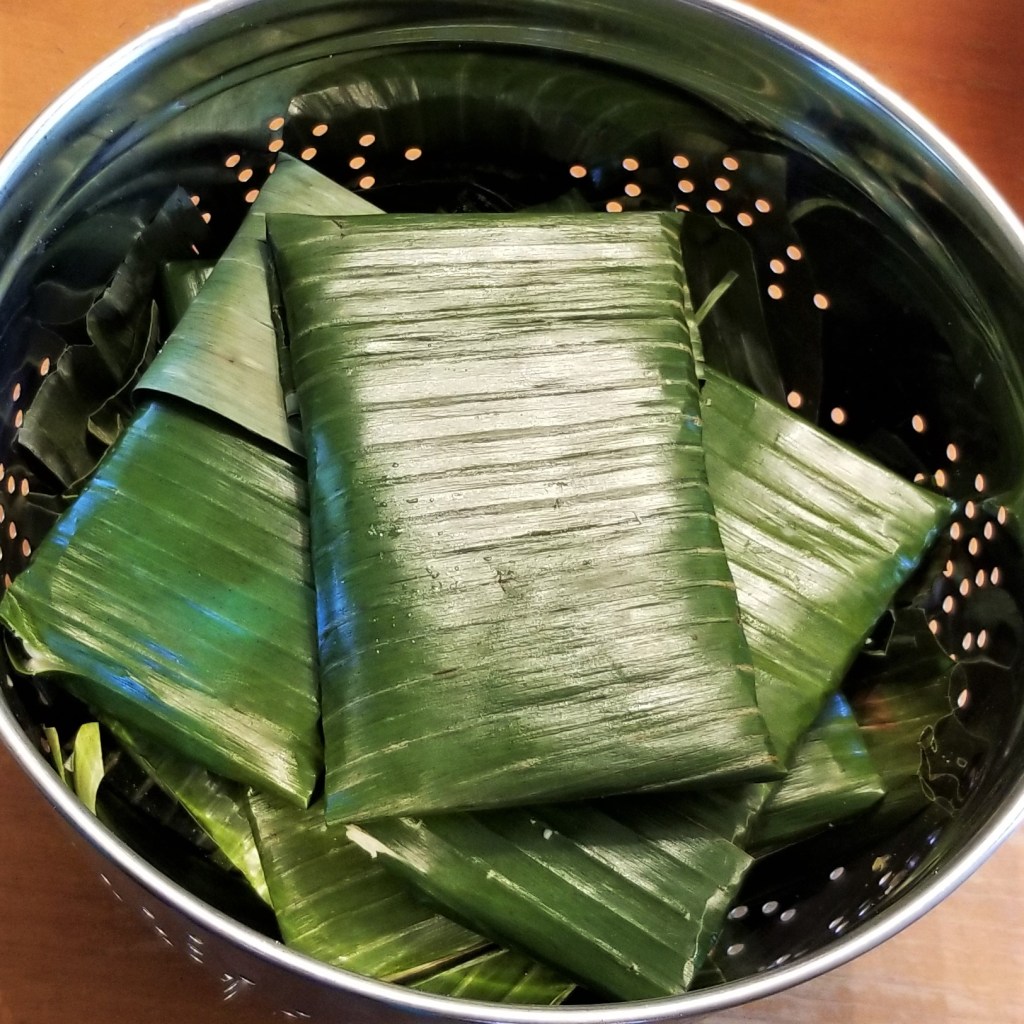
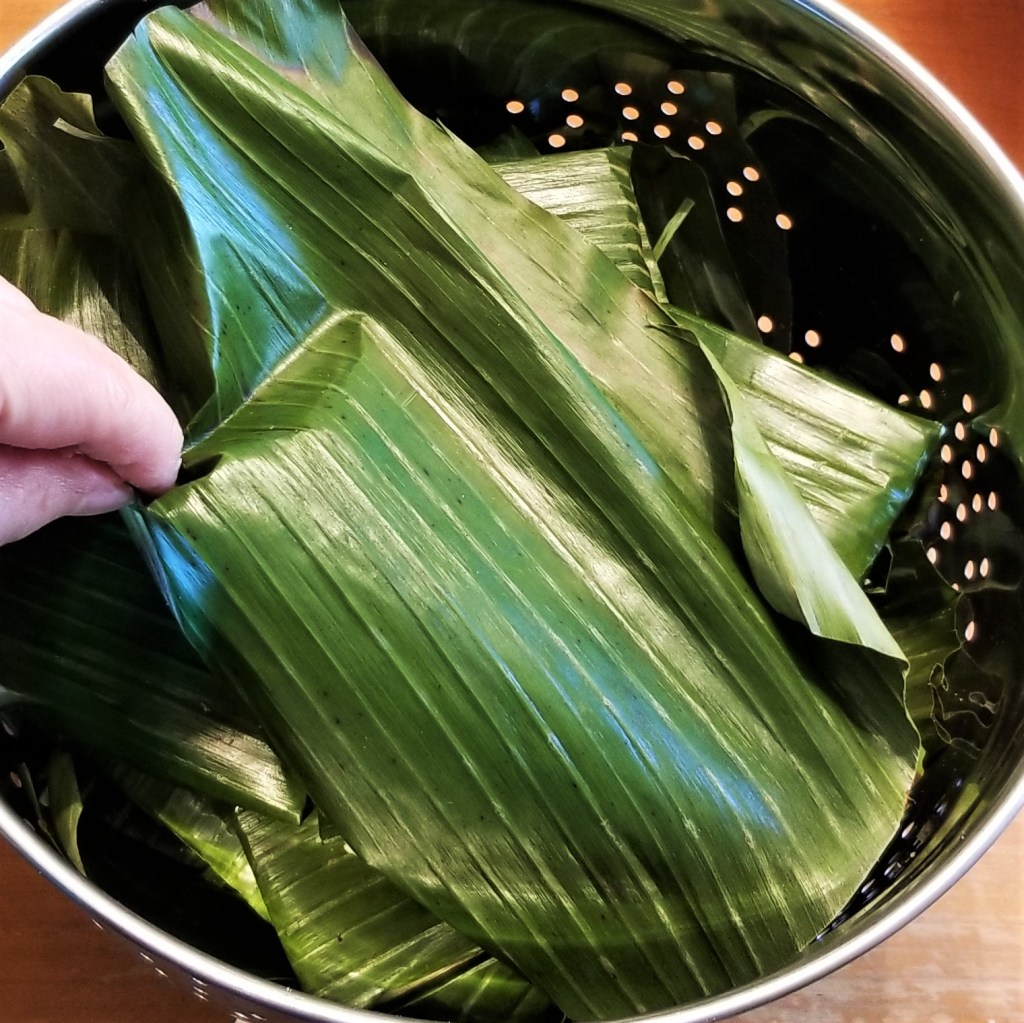
Cover with a clean kitchen towel, tucking over the tamales inside the edge of the steaming basket/colander, so the tamales will not get wet with condensation during steaming (photo below, left). Transfer basket/colander and fit on top of pot with boiling water, making sure the basket does not touch the water (photo below, right):
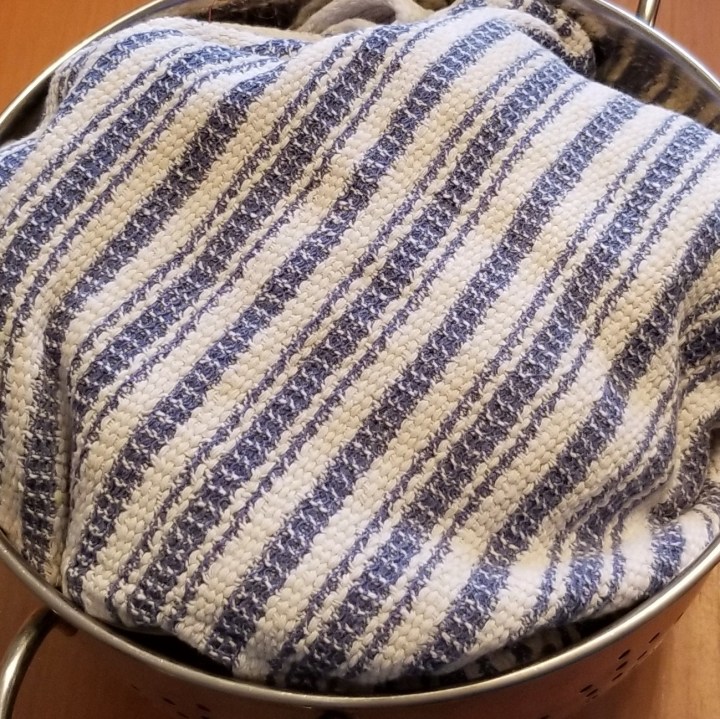
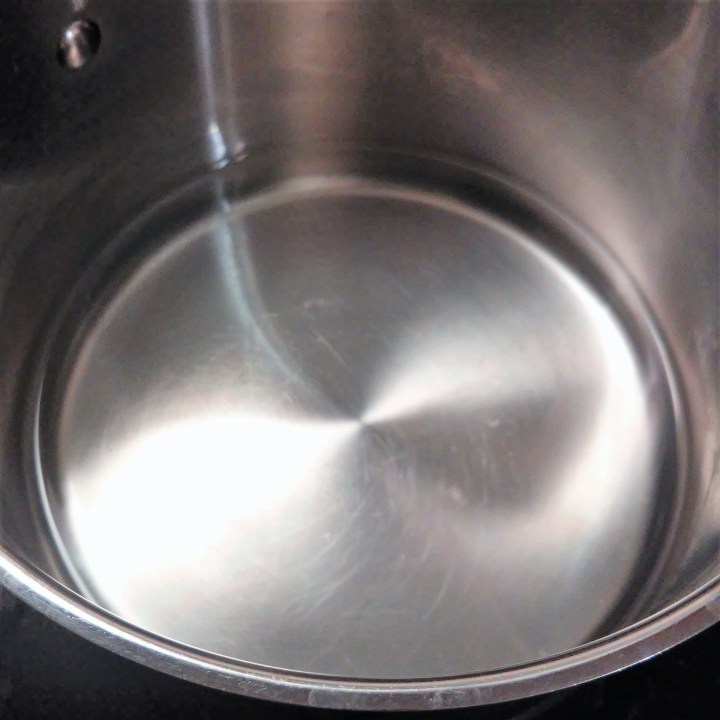
Place lid on, completely closing the top (photo below, left). Cook over high heat to make sure the water is boiling, then reduce to a rolling boil, and let the tamales steam for at least one hour. I always check the bottom of the pot halfway through, to make sure it is not drying too fast; if needed, add boiling water. After one hour, carefully open the pot and move towel to the side (photo below, right):
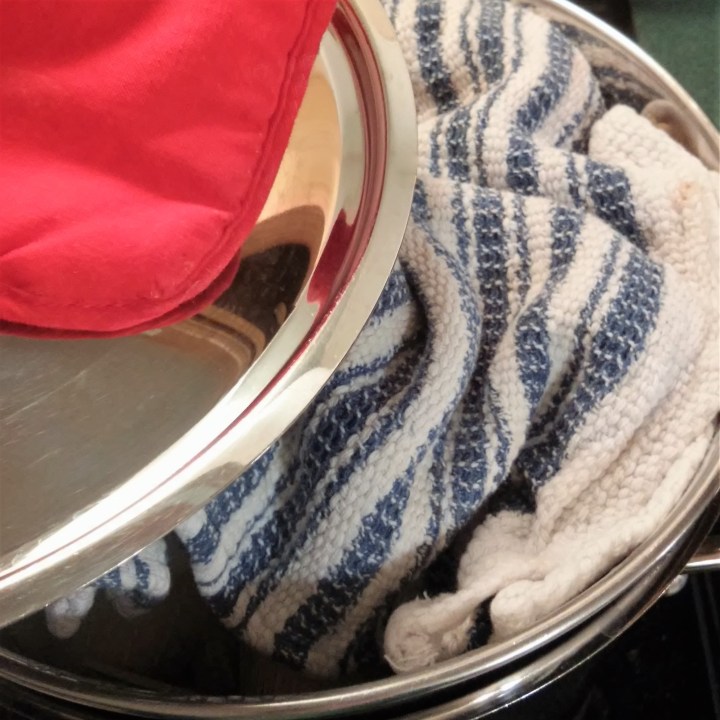
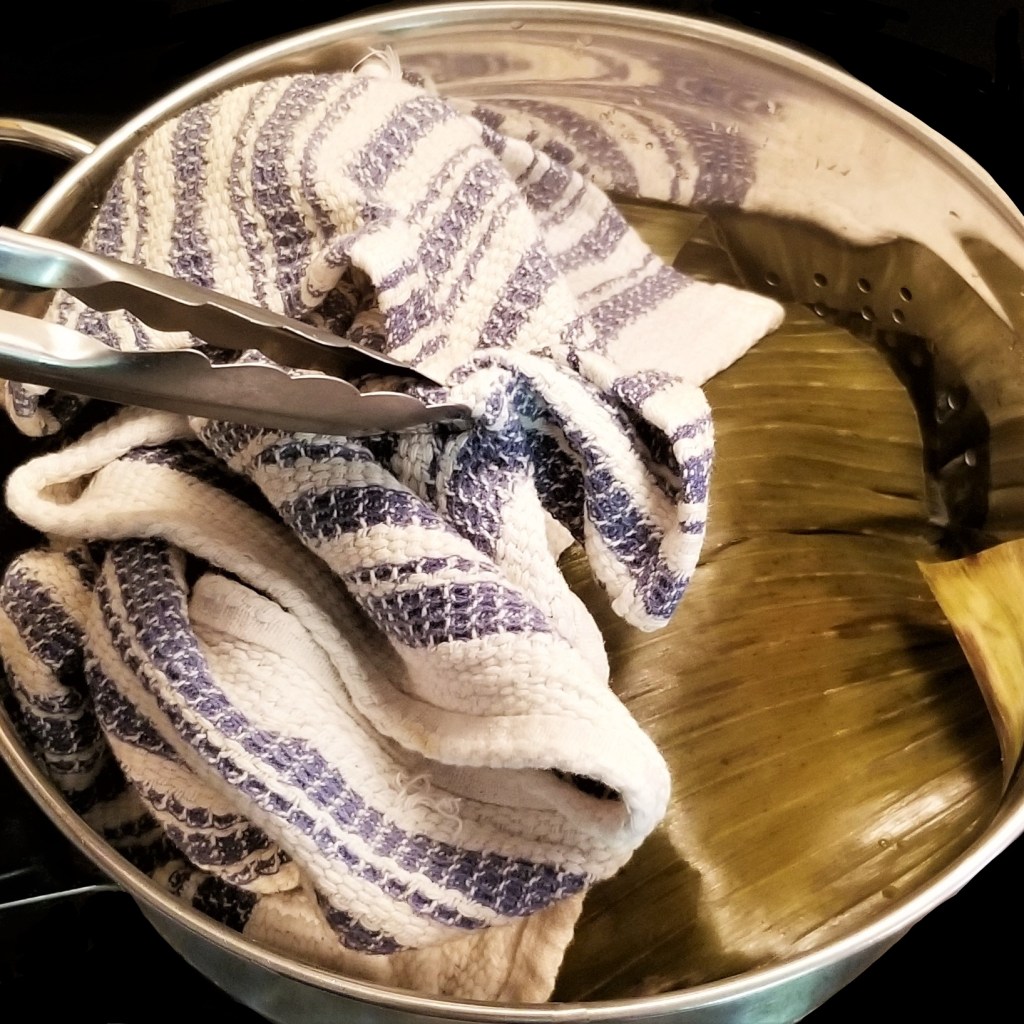
Remove one tamale, and check doneness by unwrapping; the tamale is ready when it separates easily from the leaf, as seen below for a green sauce tamale:
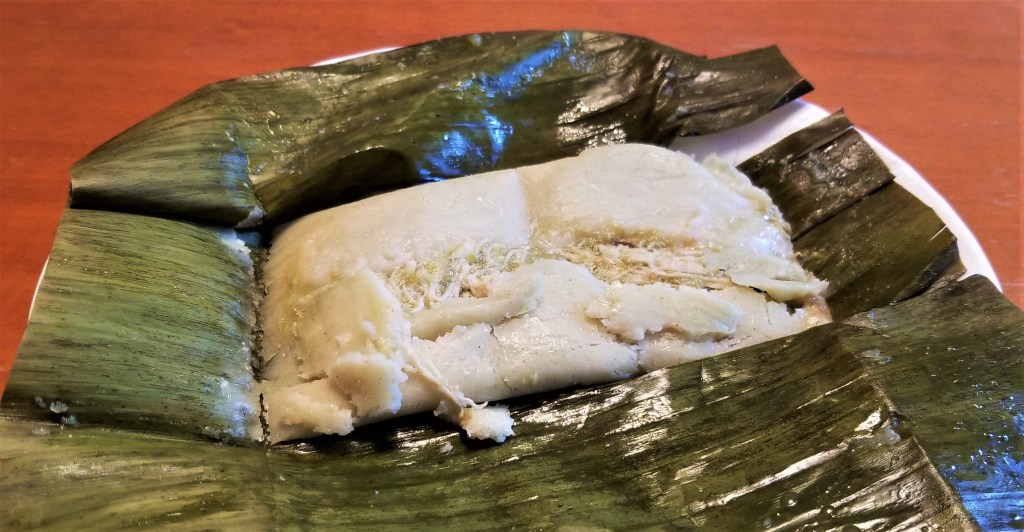
And in the photo below, for a mole tamale:
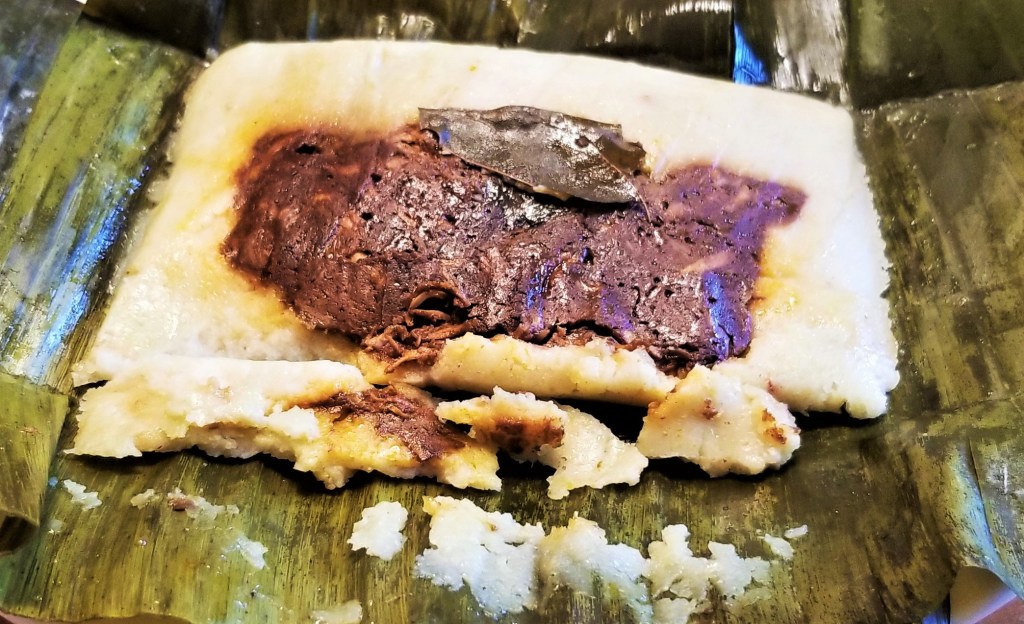
My batch needed exactly one hour, but if necessary, rewrap sample, return to the basket, cover, and continue steaming at ten minute intervals.
When sliced, the fully cooked tamales reveal a porous texture, and a delicious melding of flavours of nixtamalized corn and fillings:
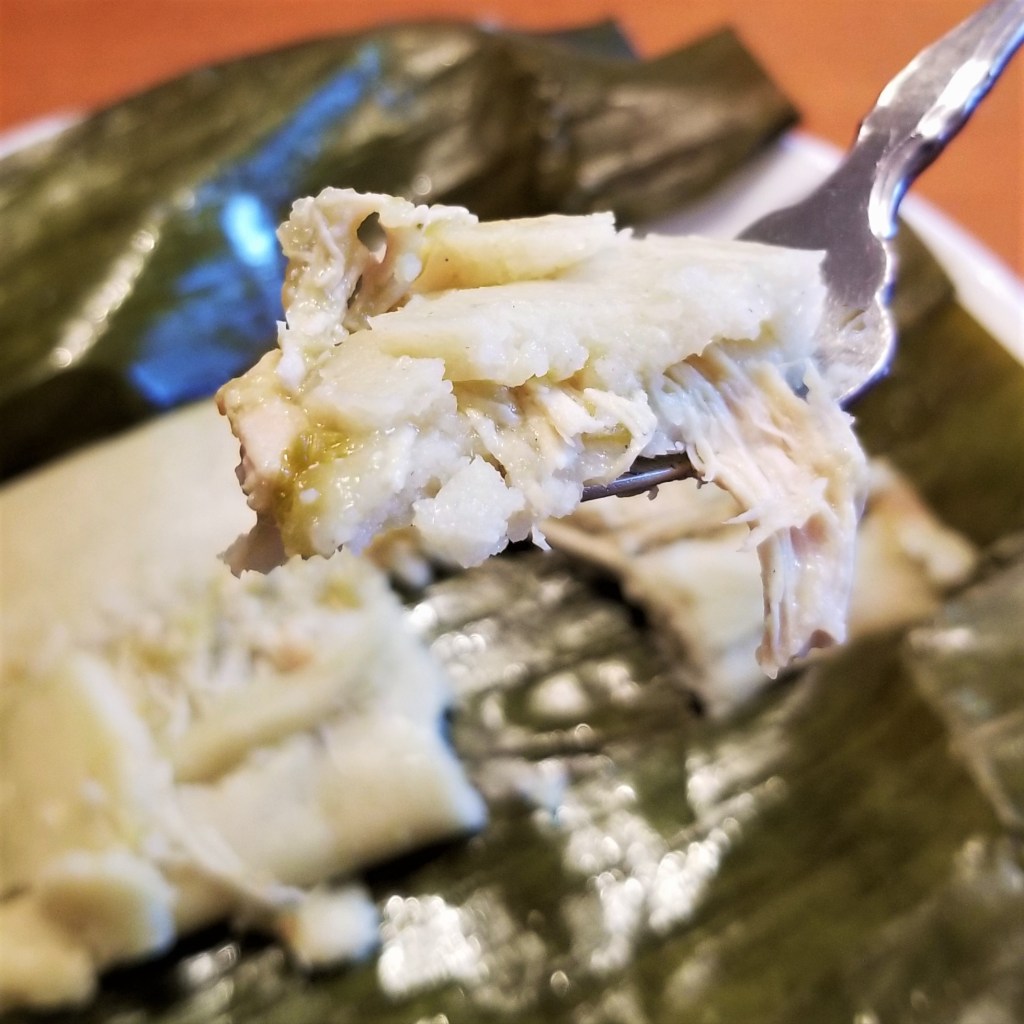
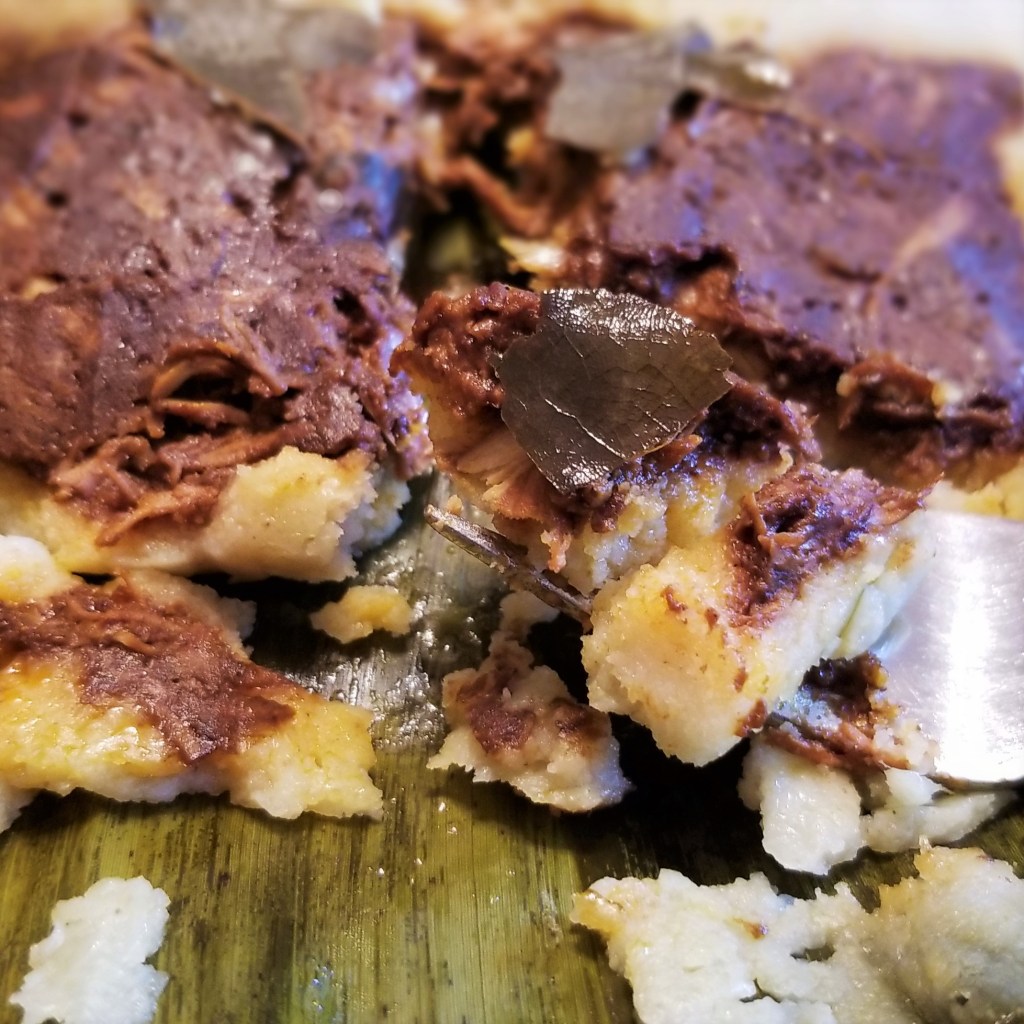
A batch of Oaxaca style tamales is a wonderful choice to offer on February 2, while hosting a Candlemas meal, or any midwinter gathering, to keep everybody cosy and warm. Although not the same as being in Mexico with relatives and friends, these tamales offer a tasty consolation, and I sure had a stroll down memory lane, picturing that lady selling her oaxaqueños out of a bucket, near my parents’ place in Mexico City…

For your convenience, click on the images below for products available on Amazon™. DISCLAIMER: Any reviews included in this post are my own, for items I have purchased, not provided by any company; as an Amazon Associates Program affiliate, I might receive a commission for any purchases originated from the links below, at no extra cost to you (thank you to readers who have bought other products starting with a click from my links!):
I am sharing my post at Thursday Favourite Things #526, with Bev @ Eclectic Red Barn, Pam @ An Artful Mom, Katherine @ Katherine’s Corner, Amber @ Follow the Yellow Brick Home, Theresa @ Shoestring Elegance and Linda @ Crafts a la Mode.
I am bringing my recipe to Full Plate Thursday #574 with Miz Helen @ Miz Helen’s Country Cottage.
I am also joining Fiesta Friday #418, with Angie @ Fiesta Friday.
I am also sharing this post at What’s for Dinner? Sunday Link-Up #353, hosted by Helen @ The Lazy Gastronome.











Another similarity, Irene! 🥰 We too use banana leaves extensively to steam or bake food.
LikeLiked by 1 person
😄👍
LikeLike
Looking, but not reading my mind flipped to pasteles also cooked in banana leaves.
LikeLiked by 1 person
Yummy!
LikeLiked by 1 person
Looks fantastic – not sure I can get the banana leaves though here in the UK but maybe I could think of something else thanks for sharing
LikeLike
South Asian food stores often carry them. A last resort is Aluminum foil, but of course, that’s a last resort.
LikeLike
Thanks 🙂
LikeLiked by 1 person
Here in south India, we make a sweet snack steamed in banana leaves. The filling is made up of grated fresh coconut with or without sliced bananas. For the outer covering normally we use powdered rice or all purpose flour.
I am intrigued by this recipe and look forward to trying it! 🙂
LikeLike
Oh, sounds nice! I hope you get to try the tamales.
LikeLiked by 1 person
Oops, I left out the jaggery/sugar used in the filling too.
LikeLiked by 2 people
Pinned!! I need to try these! Thanks for sharing at the What’s for Dinner party. Hope you have a wonderful week!
LikeLiked by 1 person
Thank you, Helen, and thank you for hosting another great party!
LikeLiked by 1 person
I haven’t tried tamales in banana leaves; they sound incredibly delicious!
LikeLiked by 1 person
They are very tasty!
LikeLiked by 2 people